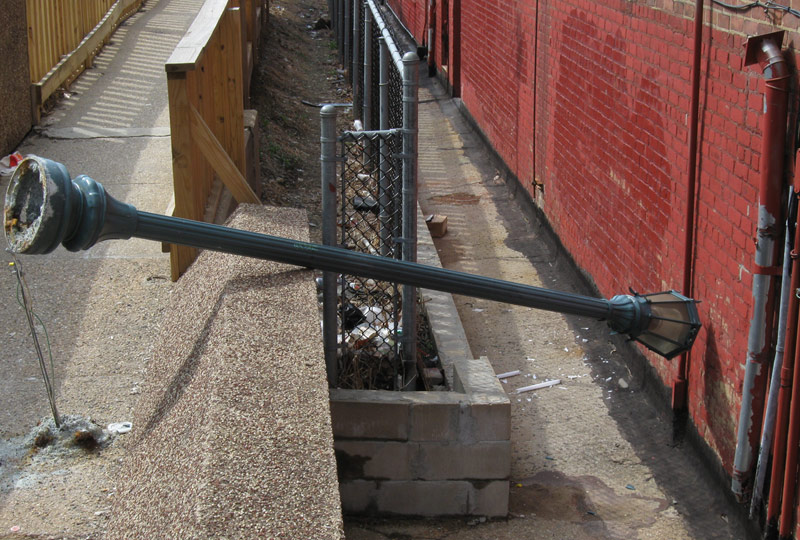Despite your best-laid plans, at some point during the prep, shoot or post, a monster fuck-up (or a few small ones) are going to come along and take a dump on said plans. Apart from the obvious (try to stay calm, get your plan B ready) what do you do?
Shoot Something
For some reason (that’s still not clear), we lost our NYPD TCD (Traffic Control Division, who are also responsible for police presence on set) on a particular day we needed them. In New York City, you are not allowed to shoot scenes with “film cops” without real ones being around. Otherwise, some other real cops might wonder what the hell is going on.
Since we had a full day of shooting scheduled with Morton and Jess, our ‘Psychcops,’ I was in real trouble. My DP (Ben Wolf), sound mixer (Anthony Viera), and I sat down for a few minutes and figured out what angles/parts of the scenes we had scheduled that we could shoot without Morton and Jess. Meanwhile my crack PAs called Curt and Mollie (who played Morton and Jess) and told them they weren’t needed that day. According to SAG regulations, I had to pay them for the day, which sucked, but it was better than trying to pull a fast one on the police. If we had been caught in violation of our permit they could revoke it and then we’d be really screwed.
As it turned out, we were able to shoot about 80 percent of what we had scheduled, and we added a scene that we’d originally scheduled for the next day. So despite not having a plan B, we were able to salvage the day. The lesson here is to keep shooting despite the obstacles. Come up with something – anything. You can’t afford to be down for more than a couple of hours on a low budget shoot.
Replace
Sooner or later, someone will become an obstacle in your path. It could be a crew member with an attitude, a cast member with a schedule conflict that can’t be worked around, an agent who’s putting the hammer to your balls on ‘behalf’ of his client, an investor who insists on a LOT of special treatment before signing that check, a location owner or vendor that keeps changing the deal on you. These people may be your friends. They may be acting from completely benign motives – anxiety, loyalty to their client/organization, a misunderstanding, or because they’ve been burned by producers in the past. In any case, you have to make a decision: is this aggravation worth it? It may not be. Start looking for a replacement.
The horrible thing about being the boss is that you may have to replace someone for the good of the project. You will have to put your loyalties to the person to one side.
Chances are, the replacement person will be better than you’d hope for. The knot in your stomach will go away surprisingly fast.
Consult
Chances are, your crew has been through whatever fire you’re going through. In fact, they’ve probably encountered it a lot more often than you – a DP can work on many features in a year, whereas you can probably only direct or produce one every two to three. It’s not weakness to ask for advice – it’s common sense. It also invites people into the creative process, which is a good thing.
On Found In Time, we were shooting in a narrow corridor, and I couldn’t figure out how to make the script blocking match the location. I knew going in that it was a tough location but didn’t have much choice – I’d run out of time to investigate alternatives and the price was right. On the day, I was still figuring out how to position my leading man between the two leading ladies, even though it clearly wouldn’t work with the geography of the place. Ben came up with a solution instantly – just change the door that one of the characters was coming out of – and then everything snapped into place. Instead of me staring into space for an hour trying to figure it all out we were shooting in about fifteen minutes.
Punt
On Found In Time, we had a monster 15-hour day on our soundstage (as a result of poor scheduling on my part) on day 11, so everyone was pretty tired by the end of day 12. The shoot was dragging and I wasn’t getting what I wanted from anyone, including myself. My brain was the consistency of cottage cheese. I realized that if I pushed us up to the 12th hour, that we were still not going to wrap out of the scenes we needed to shoot, and the work was going to suffer. By pushing the scenes to the next day – our last day of shooting – I was taking a chance. We already had about 8 pages to shoot, and a hard out on the location and some of our cast members. Adding another 2 pages seemed insane.
But on the other hand, we WERE coming back to the location the next day. After looking at the existing 8 pages we had to shoot, we realized that we could tuck the owed scenes into the end of the day without screwing anything else up. This proved to be the correct decision – people got some sleep, we were able to start a little earlier, and we got better work done.
Consolidate, or Break Apart
Sometimes consolidating your setups is a good idea – unless it results in a complicated pretzel-twist setup or creates other problems that you’ll never get out of.
On Windows, a film I lined produced, one ten minute scene was supposed to be shot in one take. On paper it looked easy enough – two characters in a room, talking, then arguing, then fighting. But the location turned out to be full of mirrors, and the blocking got very complicated. So there was no way that the DP WASN’T going to see himself in one of the mirrors at some point.
After trying to shoot it all in one take, Ben and Shoja Azari (the director) talked it over and decided to shoot ‘sort-of’ coverage. This meant shooting moving masters from different angles, trying to avoid the mirrors as much as possible, and emphasizing different elements from take to take. By shooting the scene this way, the editor had enough material to cut with, without sacrificing the ‘feeling’ of the single take. Some people who’ve watched the film aren’t aware that it’s actually several shots stitched together.
On the other hand, on Caleb’s Door (my first film), I had the opposite problem. I was three hours behind and we were shooting a four-page dialog scene between the two lead characters, Liz and Caleb. Liz and Caleb were sitting side by side at a bar, looking at each other. This would normally call for four-to-six setups. A master shot looking down the bar at Liz, a reverse looking at Caleb, then CUs of both of them, then cutaways, then a double (if possible) from behind the bar. There was no way to accomplish this and make the rest of the day.
Then something wonderful happened. Ben put the camera on the bar for the master on Liz, which would normally just get the back of Caleb’s head. But Carl, the actor playing Caleb, ended up playing the scene looking AWAY from Liz and at the bar. In other words, he was in profile for nearly the entire scene – so we were able to get both actors’ faces in one master shot. Plus, since he was closer to the camera, it worked as his CU except for three lines, when he finally does turn to Liz. So we shot the three lines as a separate CU, then shot a CU of Liz. This gave us enough material to cut with, and saved us three setups. I wish could take credit for it, but the main point is that it got us out of a major jam. and it worked really well.
Failure Is Just Another Opportunity To Learn
It may be that nothing works, that the shoot falls apart anyway, and you don’t get everything you need. It sucks, and it’s the worst feeling in the world. But it’s not the end. There isn’t a single great painter, sculptor, writer, business owner, scientist, parent, cook – a single great anything – that doesn’t have a failure in their past. A script that didn’t come together, a restaurant that never opened or failed, an experiment that blew up, a novel that bombed. Sometimes what separates the wheat from the chaff in the film business is what you do after you fail. Do you pack it up and do something else, or do you learn what you can, file it away, then get up (after a good night or two of drinking) and get back in the saddle? I’ve had my share of failures, and it’s taken me years in some cases to see them in anything but a negative light, but now I recognize them for what they are: learning experiences.










